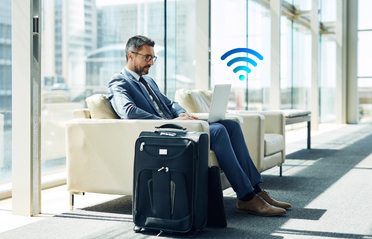Introduction
Historically, flights have been known to be a time of disconnect from the outside world. Thus, air travel service providers have strived to improve customers’ experience by engaging them through inflight connectivity and entertainment. Airship Hindenburg, the largest aircraft ever built, had an onboard piano, dining room, and a bar to gratify its passengers. With time, as heavier-than-air aircraft replaced airships, the availability of free space inside aircraft became expensive and scarce. Thus, airlines adapted to innovations occasionally to attract passengers and save costs. In the 1960s, passengers watched films using pneumatic headphones on a standard single screen, while in the 1980s, Northwest Airlines introduced drop-down screens. In the early 2000s, pneumatic headphones were replaced by electronic headphones connected to large seat-back displays. Eventually, onboard Wi-Fi enabled the Internet on flying aeroplanes and the market is still expected to rise. According to Allied Market Research inflight connectivity and entertainment, the market is expected to rise from $4.13 billion in 2020 to $11.65 billion in 2030.
Need for Inflight Connectivity Solutions
With the rise of globalization and continuous access to fast-speed Internet on the ground, users have been tuned to checking social media and browsing content in their leisure time. While flying, passengers have historically been unable to maintain connectivity with the outside world. In the post covid era, working and learning from anywhere is the norm, and lack of inflight connectivity leads to unproductive flying hours for professionals. Thus, with the inclusion of inflight connectivity, passengers’ experience can be significantly improved. It would build the airline’s reputation while facilitating secondary revenue generation.
How is connectivity brought to aeroplanes?
Today connectivity on flights is brought with the help of onboard Wi-Fi networks. These networks provide access to on-flight content like movies, camera views, flight routes/maps, flight information, or the Internet. On-flight content is distinct and dynamic for every airline, but the general trend is a collection of early-window, late-window, and regional content. Airlines directly negotiate the price of content with the content owners to attract customers.
Bringing the Internet to Flights:
The Internet on an aeroplane can be established by connecting to either cell towers or satellites. Establishing an internet connection using signals received from cell towers is called Air to Ground transmission (ATG). Such a connection can be made only when the aeroplane is above the ground and not the sea, with a maximum speed of merely 3 Mbps compared to a cellular internet speed of nearly 30 Mbps. The Internet is established through satellites when a satellite reflects signals from a ground station to an aeroplane. The maximum internet speed for Ku-Band (12 to 18 GHz microwave) is 50 Mbps, while for Ka-Band (26.5 to 40 GHz microwave) is 70Mbps. However, the actual connection speed experienced is much lower since the Internet is often shared between multiple aeroplanes flying at a breakneck speed.
Device Onboarding of Passengers:
Device onboarding of passengers can be manual or automated. While onboarding manually, passengers do not require a Passpoint subscription. They can manually select SSID, enter the flight portal’s URL and register to the network. The flight portal gives passengers access to services like duty-free shopping and internet data purchases.
In automated onboarding, the user’s device is configured with a Passpoint subscription that the airline provides while buying tickets or through loyalty applications. Dynamic Host Configuration Protocol (DHCP) automatically allocates IP addresses to network hosts and enables notifications on devices to access captive portal service. Thus, the process of establishing a connection is automated and cellular-like. With the advent of services like open roaming by WBA, users switch between multiple networks throughout the flight for seamless access to the Internet.
Benefits of having Inflight Connectivity
Here are some of the benefits of enabling inflight connectivity:
Competitive advantage: In today’s hyper-connected world, any airline with stable connectivity is bound to have an advantage over its competitors. The airline’s approach when bringing high-speed or cost-effective Internet should depend on the demographics and choices of the passengers it serves.
Enhance customer experience with inflight connectivity: Inflight connectivity keeps passengers engaged in the activities of their choice. By providing a wide variety of content, airlines can enhance passengers’ flying experience. This leads to increased loyalty and recommendation through word of mouth, a favourable situation for the airlines and passengers alike.
Secondary revenue generation: Airlines can generate additional revenue by making the on-flight content free and Internet chargeable based on data consumed. Secondary revenue generation with inflight connectivity can be attained using passenger invoices based on data usage by individual devices. Depending on their needs, passengers may opt to use or not use the service. Hence, there is no unnecessary monetary push on passengers.
Feedback Mechanism and Analytics: With the help of inflight connectivity, airlines can understand the likes and dislikes of passengers and tailor content accordingly. This can be done by aligning inflight content with the demographic profile of each passenger. A short, non-compulsory digital feedback form can bring massive data about improving services and problems faced during the flight.
Challenges in providing Inflight Connectivity
While having inflight connectivity has a bunch of benefits, it also comes with its own set of challenges:
Inconsistency in customer experience: Aeroplanes fly at a very high speed, and their location continuously changes. Hence, they must switch between networks repeatedly, which are often shared between multiple aeroplanes. Furthermore, newer aeroplanes are better equipped with the latest technology when compared to former models. Combined, these factors lead to an inconsistency in the passenger’s experience.
Invoice shock: The price of internet usage overflight is much higher than on the ground. Many passengers on board may not be familiar with the concept of megabits of the Internet as, on the ground, they are spoiled to unlimited access. Additionally, several mobile applications run and update in the background consuming unnecessary data. As a result, invoice shock and subsequent dissatisfaction of passengers become a significant challenge to inflight connectivity.
Limited access due to Geopolitical issues: The law of the land governs the Internet, and many websites available in one country might not be available when the plane connects to another country’s internet. Also, many businesses personalize their website’s content based on geolocation; this incorrect personalization may cause inconvenience to passengers.
Usage Tracking: Since the Internet available on board is limited and usually slow, usage tracking of individual devices becomes challenging. Moreover, airlines must ensure equitable content distribution and internet access throughout the journey to avoid discontent amongst passengers.
Methods and Tools of dealing with Challenges to Inflight Connectivity
Virtual Private Network: VPNs facilitate access to any website from anywhere. They establish an encrypted internet connection that disguises the user’s IP address and hides their location. VPNs also make connections secure from external threats.
CAPPORT API: A Captive portal or a CAPPORT displays network-related information and prompts users to enter credentials before accessing the Internet. This information can be vital for an equitable distribution of bandwidth, accurate usage tracking, and invoice generation. Displaying charges explicitly on the captive portal can also help prevent invoice shock.
Dynamic Host Configuration Portal (DHCP): A DHCP Server automatically allocates IP addresses to all network hosts, notifies users, and prompts them to access the captive portal service. DHCP and a captive portal simplify establishing the Internet for each passenger.
OpenRoaming: OpenRoaming by Wireless Broadband Alliance (WBA) helps passengers maintain a stable internet connection by switching to multiple networks throughout the journey.
Additionally, OpenRoaming enables airlines to become identity providers and distribute their own subscription plans.
Next-generation hotspot (NGH): Next Generation Hotspot Solution by HSC is a cloud-hosted hotspot 2.0-based network solution that brings cellular-like connectivity to Wi-Fi access points. It also helps in provisioning user credentials and the network policy of an airline, making the onboarding process effortless. Whenever the passenger re-enters the airline’s network, the service is automatically enabled depending on the subscription, making it seamless and cellular-like. NGH opens doors for secondary revenue through Wi-Fi analytics via internet usage tracking and proximity marketing. By outsourcing connectivity, airlines can save costs and efforts of developing and upgrading connectivity solutions.
Connected Cabin: Connected Cabin by Collins Aerospace minimizes face-to-face interaction between passengers and crew, improving operational efficiency. For example, through a connected cabin, passengers can select food, beverages, entertainment, and the internet using their preferred devices, saving precious time for the crew from manual efforts.
Future Scope
Today, Passengers can access all the on-flight content and the Internet on their own devices by connecting to onboard Wi-Fi, eliminating the need of individual seat back screens like how Southwest does to cut CAPEX. Eventually, the screens can be replaced by a USB port to provide seamless access to inflight content anytime, saving the cost of installation and maintenance at the airline’s end.
In the future, alliances between multiple Airlines and Hotels might exist to leverage OpenRoaming’s Roaming Consortium Codes Framework (RCOI). During the journey, passengers can auto-connect to networks like airports, hotels, or any other key location using RCOI. This augmented benefit goes beyond what a passenger expects today but could be an impending possibility.
Despite all the progress and technological advances, inflight connectivity solutions cannot connect customers around landing or takeoff. Most Civil Aviation authorities prohibit use of Wi-Fi services below 10,000 feet above departure/arrival airfield elevation. The prohibition ensures that radio waves emitted from electronic devices do not cause electromagnetic interference with flight control systems.
Although today we still cannot confidently use the phrase ‘The Internet is omnipresent’ in our lingo, hopefully, as always, technology in the future will find a way out!

Product Engineering Services Customized software development services for diverse domains
Quality Assurance End-to-end quality assurance and testing services
Managed Services Achieve scalability, operational efficiency and business continuity
Technology Consulting & Architecture Leverage the extensive knowledge of our Domain Experts



